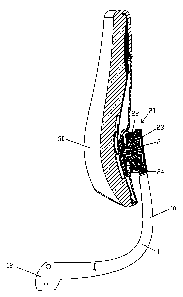Une partie des informations de ce site Web a été fournie par des sources externes. Le gouvernement du Canada n'assume aucune responsabilité concernant la précision, l'actualité ou la fiabilité des informations fournies par les sources externes. Les utilisateurs qui désirent employer cette information devraient consulter directement la source des informations. Le contenu fourni par les sources externes n'est pas assujetti aux exigences sur les langues officielles, la protection des renseignements personnels et l'accessibilité.
L'apparition de différences dans le texte et l'image des Revendications et de l'Abrégé dépend du moment auquel le document est publié. Les textes des Revendications et de l'Abrégé sont affichés :
| (12) Demande de brevet: | (11) CA 2606360 |
|---|---|
| (54) Titre français: | DOSSIER DE CHAISE |
| (54) Titre anglais: | BACK REST FOR A CHAIR |
| Statut: | Réputée abandonnée et au-delà du délai pour le rétablissement - en attente de la réponse à l’avis de communication rejetée |
| (51) Classification internationale des brevets (CIB): |
|
|---|---|
| (72) Inventeurs : |
|
| (73) Titulaires : |
|
| (71) Demandeurs : |
|
| (74) Agent: | MARKS & CLERK |
| (74) Co-agent: | |
| (45) Délivré: | |
| (22) Date de dépôt: | 2007-10-09 |
| (41) Mise à la disponibilité du public: | 2008-04-18 |
| Requête d'examen: | 2008-10-10 |
| Licence disponible: | S.O. |
| Cédé au domaine public: | S.O. |
| (25) Langue des documents déposés: | Anglais |
| Traité de coopération en matière de brevets (PCT): | Non |
|---|
| (30) Données de priorité de la demande: | ||||||
|---|---|---|---|---|---|---|
|
For a back rest for a chair with a back support (10) and a back surface (30)
secured to
this and able to swivel about a two-axis joint (20), wherein the joint (20)
has a joint plate
(21) connected to the back surface, an element made of an elastic material
that
supports the joint in a ground position, and a chamber 24 to accommodate the
elastic
element, connected to the back support (10), the invention specifies that the
joint plate
(21) is arranged in the receiving chamber (24) between two elements (22, 23)
made
from an elastic material, holding the joint in a ground position and each
being supported
against the receiving chamber (24), and it can swivel about the two swivel
axes. When
the joint (20) is placed under load, the two elastic elements (22,23) are only
subjected
to compression. There are no tension-loaded connections, as in the prior art,
which
break under loading and can result in the joint falling apart.
Note : Les revendications sont présentées dans la langue officielle dans laquelle elles ont été soumises.
Note : Les descriptions sont présentées dans la langue officielle dans laquelle elles ont été soumises.

2024-08-01 : Dans le cadre de la transition vers les Brevets de nouvelle génération (BNG), la base de données sur les brevets canadiens (BDBC) contient désormais un Historique d'événement plus détaillé, qui reproduit le Journal des événements de notre nouvelle solution interne.
Veuillez noter que les événements débutant par « Inactive : » se réfèrent à des événements qui ne sont plus utilisés dans notre nouvelle solution interne.
Pour une meilleure compréhension de l'état de la demande ou brevet qui figure sur cette page, la rubrique Mise en garde , et les descriptions de Brevet , Historique d'événement , Taxes périodiques et Historique des paiements devraient être consultées.
| Description | Date |
|---|---|
| Le délai pour l'annulation est expiré | 2011-10-11 |
| Demande non rétablie avant l'échéance | 2011-10-11 |
| Réputée abandonnée - omission de répondre à un avis sur les taxes pour le maintien en état | 2010-10-12 |
| Modification reçue - modification volontaire | 2010-08-27 |
| Inactive : Dem. de l'examinateur par.30(2) Règles | 2010-03-12 |
| Modification reçue - modification volontaire | 2009-08-14 |
| Lettre envoyée | 2008-11-13 |
| Exigences pour une requête d'examen - jugée conforme | 2008-10-10 |
| Requête d'examen reçue | 2008-10-10 |
| Toutes les exigences pour l'examen - jugée conforme | 2008-10-10 |
| Demande publiée (accessible au public) | 2008-04-18 |
| Inactive : Page couverture publiée | 2008-04-17 |
| Inactive : CIB en 1re position | 2008-03-11 |
| Inactive : CIB attribuée | 2008-03-11 |
| Inactive : Certificat de dépôt - Sans RE (Anglais) | 2007-12-07 |
| Demande reçue - nationale ordinaire | 2007-11-20 |
| Date d'abandonnement | Raison | Date de rétablissement |
|---|---|---|
| 2010-10-12 |
Le dernier paiement a été reçu le 2009-10-07
Avis : Si le paiement en totalité n'a pas été reçu au plus tard à la date indiquée, une taxe supplémentaire peut être imposée, soit une des taxes suivantes :
Les taxes sur les brevets sont ajustées au 1er janvier de chaque année. Les montants ci-dessus sont les montants actuels s'ils sont reçus au plus tard le 31 décembre de l'année en cours.
Veuillez vous référer à la page web des
taxes sur les brevets
de l'OPIC pour voir tous les montants actuels des taxes.
| Type de taxes | Anniversaire | Échéance | Date payée |
|---|---|---|---|
| Taxe pour le dépôt - générale | 2007-10-09 | ||
| Requête d'examen - générale | 2008-10-10 | ||
| TM (demande, 2e anniv.) - générale | 02 | 2009-10-09 | 2009-10-07 |
Les titulaires actuels et antérieures au dossier sont affichés en ordre alphabétique.
| Titulaires actuels au dossier |
|---|
| SEDUS STOLL AKTIENGESELLSCHAFT |
| Titulaires antérieures au dossier |
|---|
| HARRY FISCHER |
| PETER MAIER |